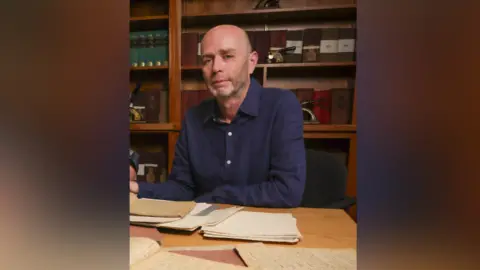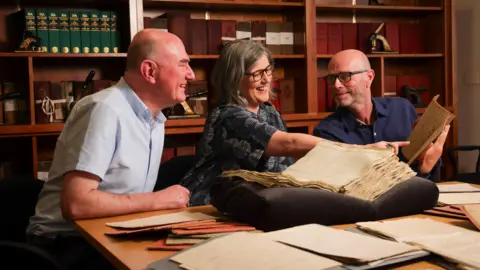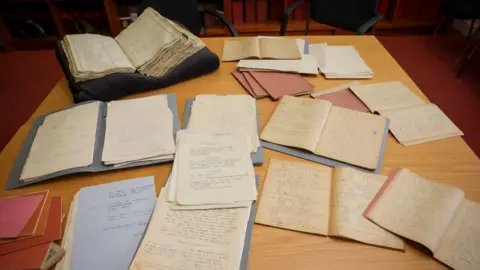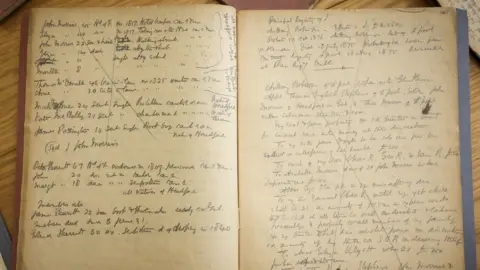Virtual records unveil lost history of Ireland
 Trinity College Dublin
Trinity College DublinGenealogical riches from every county of the island of Ireland feature among 175,000 new historical records which are now available online.
For the first time there are now 60,000 names on the Virtual Record Treasury of Ireland from the 1821 census which was destroyed in 1922.
The Four Courts blaze destroyed the Public Record Office of Ireland, and with it seven centuries of Irish history.
Co-Director of the virtual records, Dr Ciarán Wallace said handwritten copies of records have enabled the archives to expand.
"What we've learned is that in the days before photocopiers and scanners, humans with pens or quills wrote tonnes and tonnes of copies of records, they could make copies for all sorts of reasons, for administrative reasons or for a court case, or for family research," he said.
The 1821 portal was compiled by hand, from transcriptions and notes preserved in the National Archives of Ireland and Public Record Office of Northern Ireland.
The recovered transcripts of census returns revealed ordinary lives across the island of Ireland in the decades before and after the Great Famine, that were previously lost.
Nine thousand new names for Co Armagh
Dr Brian Gurrin, Census and Population expert, explained: "The 1821 census recorded the names of 6.8 million people and those names were contained in the public record office in 479 massive volumes.
"Four volumes survived out of that and one of them is for a part of County Fermanagh, that's one of the original surviving volumes."
County Armagh is one of the most documented counties across the island of Ireland.
"We have introduced for some counties, a very small number of names, but for County Armagh we've introduced over 9000 names available in the Virtual Record Treasury. It is the largest number of names for any county in Ireland," Dr Gurrin said.
 Trinity College Dublin
Trinity College DublinIrish genealogy
The portal has been made possible because of the personal notes made by 20th century genealogists.
Dr Gurrin said: "I think it's 24 boxes of Tenison Groves' papers in Belfast. And we've worked through the Gertrude Thrift and Phillip Crossley's papers down in Dublin working page by page, by page, trying to identify census extracts that were taken by them that don't exist anymore in the originals."
Dr Gurrin believes that this is the most extensive trawl that was ever conducted on these genealogical papers in order to extract "every scrap of census information".
"I think we've looked at over 150,000 individual pages searching down through them to try to find the various census extracts that they would have taken."
He said: "They were always available, but what we've done is we've made them available in one convenient place."
 Trinity College Dublin
Trinity College DublinThe team works with 72 different archives and libraries across the UK, Ireland and the world to identify copies of material that may be of use.
"We make nice lists of them and where we can get digital images, we do.
"It's not just genealogy, but all sorts of records, local history stuff and everything there for the whole island of Ireland," Dr Wallace said.
Ireland paved the way for census taking, as Great Britain did not start recording the names of all people until 1841, twenty years later.
Armagh County Museum is a partner with the project.
Sean Barden, curator at the museum, said: "Digital platforms like this are essential tools for museums, they allow us to share rare and valuable material, such as our transcript of the 1821 Kilmore parish census fragment, with a much wider audience."
He said by hosting it online, the Virtual Treasury will help researchers and shine a light on the strength and significance of the museums collections.
 Trinity College Dublin
Trinity College DublinThough many parts of Ireland at the time spoke and wrote in Irish, names and places in the census were recorded in English.
Dr Gurrin said the census of the Aran Islands has been added "and even though it was 100% Irish speaking in 1821, there's not a single mention of the Irish language in the census.
"The enumerator doesn't say that the people here speak a different language.
"And there's not a single Sean, or any sort of Irish first name recorded in it at all.
"They're all recorded in English, so any anybody who is Padraig will be Patrick."
Dr Wallace said: "It is just fascinating to be able to track back and find records of ancestors, in court cases or in dealing with the state in some way, sometimes positive, sometimes negative, but it sort of fleshes out their lives, gives us a sense of what their lives were like."
